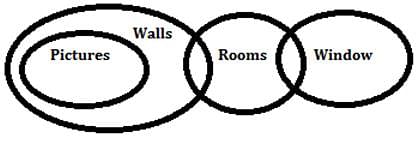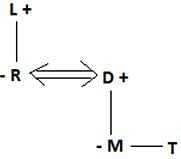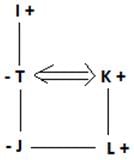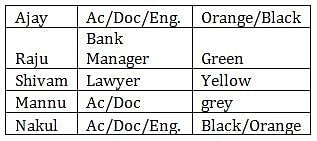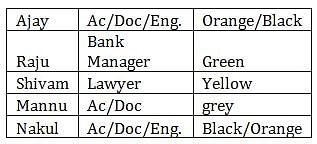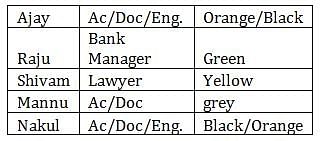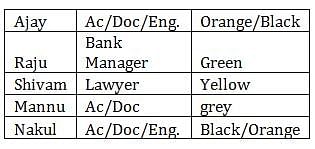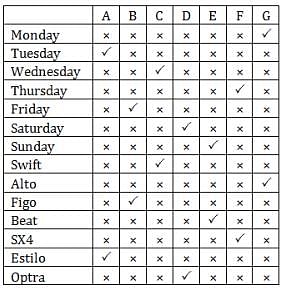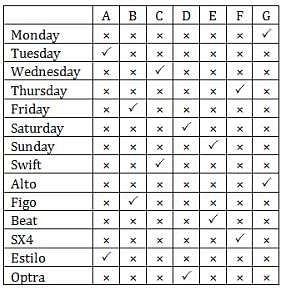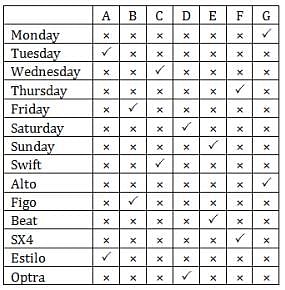NABARD Reasoning Practice : 1 - Bank Exams MCQ
30 Questions MCQ Test NABARD Assistant Manager Grade A Mock Test Series 2024 - NABARD Reasoning Practice : 1
In each of the questions below are given three statements followed by three conclusions numbered I, II and III. You have to take the given statements to be true even if they seem to be at variance from commonly known facts. Read all the conclusions and then decide which of the given conclusions logically follows from the given statements disregarding commonly known facts.
Statements:
All books are tents.
Some tents are lakes.
All lakes are ponds.
Conclusions:
I. Some ponds are books.
II. Some ponds are tents.
III. Some lakes are books
All books are tents.
Some tents are lakes.
All lakes are ponds.
Conclusions:
I. Some ponds are books.
II. Some ponds are tents.
III. Some lakes are books
In each of the questions below are given three statements followed by three conclusions numbered I, II and III. You have to take the given statements to be true even if they seem to be at variance from commonly known facts. Read all the conclusions and then decide which of the given conclusions logically follows from the given statements disregarding commonly known facts.
Statements:
All pictures are walls.
Some walls are rooms.
Some rooms are windows.
Conclusions:
I. Some windows are walls.
II. Some windows are pictures.
III. Some rooms are walls
All pictures are walls.
Some walls are rooms.
Some rooms are windows.
Conclusions:
I. Some windows are walls.
II. Some windows are pictures.
III. Some rooms are walls
| 1 Crore+ students have signed up on EduRev. Have you? Download the App |
In each of the questions below are given three statements followed by three conclusions numbered I, II and III. You have to take the given statements to be true even if they seem to be at variance from commonly known facts. Read all the conclusions and then decide which of the given conclusions logically follows from the given statements disregarding commonly known facts.
Statements:
All baskets are marbles.
Some marbles are sticks.
No stick is garden.
Conclusions:
I. Some gardens are baskets.
II. Some sticks are baskets.
III. No garden is basket
Statements:
All baskets are marbles.
Some marbles are sticks.
No stick is garden.
Conclusions:
I. Some gardens are baskets.
II. Some sticks are baskets.
III. No garden is basket
In each of the questions below are given three statements followed by three conclusions numbered I, II and III. You have to take the given statements to be true even if they seem to be at variance from commonly known facts. Read all the conclusions and then decide which of the given conclusions logically follows from the given statements disregarding commonly known facts.
Statements:
Some bulbs are tubes. Some tubes are wires.
Some wires are lamps.
Conclusions:
I. Some lamps are tubes.
II. Some wires are bulbs.
III. Some lamps are bulbs.
In each of the questions below are given three statements followed by three conclusions numbered I, II and III. You have to take the given statements to be true even if they seem to be at variance from commonly known facts. Read all the conclusions and then decide which of the given conclusions logically follows from the given statements disregarding commonly known facts.
Statements:
All buildings are rivers.
All rivers are jungles.
All jungles are mountains.
Conclusions:
I. Some mountains are rivers.
II. Some jungles are buildings.
III. Some mountains are buildings.
Each of the questions below consists of a question and two statements numbered I and II given below it. You have to decide whether the data provided in the statements are sufficient to answer the question. Read both the
statements and
Give answer
Q. What is the code for 'is' in the code language?
I. In the code language, ‘shi to ke' means 'pen is blue'.
II. In the same code language, ‘ke si re' means 'this is wonderful'.
Each of the questions below consists of a question and two statements numbered I and II given below it. You have to decide whether the data provided in the statements are sufficient to answer the question. Read both the statements and
Give answer
Q. Which train did Harish catch to go to office?
I. Harish missed his usual train of 10.25 a.m. A train comes in every 5 min.
II. Harish did not catch the 10.40 a.m. train or any train after that time.
Each of the questions below consists of a question and two statements numbered I and II given below it. You have to decide whether the data provided in the statements are sufficient to answer the question. Read both the statements and
Give answer
Q. How is Vandana related to Prabha?
I. Mallika's sister Vandana is Rajesh's wife. Prabha is Rajesh's good friend.
II. Prabha is Rajesh's brother's wife and Vandana is Rajesh's wife.
Each of the questions below consists of a question and two statements numbered I and II given below it. You have to decide whether the data provided in the statements are sufficient to answer the question. Read both the statements and
Give answer
Q. Who earns the highest among the five friends ?
I. Priya earns more than Pinky and Sheetal and less than only Shilpa.
II. Sheetal earns more than Neetu but less than Pinky.
Each of the questions below consists of a question and two statements numbered I and II given below it. You have to decide whether the data provided in the statements are sufficient to answer the question. Read both the statements and
Give answer
Q. Who is sitting to the immediate right of Tanvi among five friends sitting around a circle facing the centre?
I. Ansh is sitting exactly between Bindu and Suresh and Neel is sitting to the immediate right of Suresh.
II. Tanvi is sitting exactly between Bindu and Neel and Ansh is sitting to the immediate right of Bindu.
Read the information carefully and answer the following questions:
A + B means A is the father of B.
A × B means A is the sister of B
A $ B means A is the wife of B.
A % B means A is the mother of B.
A ÷ B means A is the son of B.
Q. What should come in place of question mark to establish that J is brother of T in the expression?
J ÷ P % H ? T % L
Read the information carefully and answer the following questions:
A + B means A is the father of B.
A × B means A is the sister of B
A $ B means A is the wife of B.
A % B means A is the mother of B.
A ÷ B means A is the son of B.
Q. Which of the given expressions indicates that M is daughter of D?
Read the information carefully and answer the following questions:
A + B means A is the father of B.
A × B means A is the sister of B
A $ B means A is the wife of B.
A % B means A is the mother of B.
A ÷ B means A is the son of B.
Q. Which of the following options is true if the expression I + T % J × L ÷ K is definitely true?
Read the information carefully and answer the following questions:
A + B means A is the father of B.
A × B means A is the sister of B
A $ B means A is the wife of B.
A % B means A is the mother of B.
A ÷ B means A is the son of B.
Q. Which of the following option is true if the expression W% L×T×Y÷X is definitely true?
Read the information carefully and answer the following questions:
A + B means A is the father of B.
A × B means A is the sister of B
A $ B means A is the wife of B.
A % B means A is the mother of B.
A ÷ B means A is the son of B.
Q. What should come in place of question mark to establish that T is sister-in-law of Q in the expression.
R % T × P ? Q + V
Study the following information carefully to answer the following questions:-
Five friends named – Ajay, Raju , Shivam, Mannu and Nakul have different professions-Actor, Engineer, Doctor, Bank Manager and Lawyer. Each one wears different colours of ties-Yellow, Black, Grey, Green and orange though not respectively. Shivam is a lawyer but doesn’t wear Black or Orange colored tie. Person wearing green colored tie is neither an Actor nor a Doctor. Ajay and Nakul are not Bank manager and they do not wear Yellow colored tie. Grey colored tie is worn by Mannu, who is neither an Engineer nor a Bank Manager. Bank Manager wears Green colored tie.
Q. If the black tie wearer is an engineer, then which of the following is definitely true?
Study the following information carefully to answer the following questions:-
Five friends named – Ajay, Raju , Shivam, Mannu and Nakul have different professions-Actor, Engineer, Doctor, Bank Manager and Lawyer. Each one wears different colours of ties-Yellow, Black, Grey, Green and orange though not respectively. Shivam is a lawyer but doesn’t wear Black or Orange colored tie. Person wearing green colored tie is neither an Actor nor a Doctor. Ajay and Nakul are not Bank manager and they do not wear Yellow colored tie. Grey colored tie is worn by Mannu, who is neither an Engineer nor a Bank Manager. Bank Manager wears Green colored tie.
Q. Which of the following may be definitely false?
Study the following information carefully to answer the following questions:-
Five friends named – Ajay, Raju , Shivam, Mannu and Nakul have different professions-Actor, Engineer, Doctor, Bank Manager and Lawyer. Each one wears different colours of ties-Yellow, Black, Grey, Green and orange though not respectively. Shivam is a lawyer but doesn’t wear Black or Orange colored tie. Person wearing green colored tie is neither an Actor nor a Doctor. Ajay and Nakul are not Bank manager and they do not wear Yellow colored tie. Grey colored tie is worn by Mannu, who is neither an Engineer nor a Bank Manager. Bank Manager wears Green colored tie.
Q. Who is Bank Manager?
Study the following information carefully to answer the following questions:-
Five friends named – Ajay, Raju , Shivam, Mannu and Nakul have different professions-Actor, Engineer, Doctor, Bank Manager and Lawyer. Each one wears different colours of ties-Yellow, Black, Grey, Green and orange though not respectively. Shivam is a lawyer but doesn’t wear Black or Orange colored tie. Person wearing green colored tie is neither an Actor nor a Doctor. Ajay and Nakul are not Bank manager and they do not wear Yellow colored tie. Grey colored tie is worn by Mannu, who is neither an Engineer nor a Bank Manager. Bank Manager wears Green colored tie.
Q. Which of the following statement is definitely true?
Study the following information carefully to answer the following questions:-
Five friends named – Ajay, Raju , Shivam, Mannu and Nakul have different professions-Actor, Engineer, Doctor, Bank Manager and Lawyer. Each one wears different colours of ties-Yellow, Black, Grey, Green and orange though not respectively. Shivam is a lawyer but doesn’t wear Black or Orange colored tie. Person wearing green colored tie is neither an Actor nor a Doctor. Ajay and Nakul are not Bank manager and they do not wear Yellow colored tie. Grey colored tie is worn by Mannu, who is neither an Engineer nor a Bank Manager. Bank Manager wears Green colored tie.
Q. Which colored tie does Shivam wear?
Study the following information carefully to answer the below given questions:
A, B, C, D, E, F and G are seven members of a club. Each of them likes a day of the week viz. Monday, Tuesday, Wednesday, Thursday, Friday, Saturday and Sunday but not necessarily in the same order. Each of them has a different types of car like Swift, Alto, Figo, Beat, SX4, Estilo, and Optra but not necessarily in the same order. C likes Wednesday and his favourite car is neither SX4 nor Optra. E does not like Monday and his favourite car is Beat. One who likes Friday, likes Figo. One who likes Estilo car likes Tuesday. D likes Saturday and his favourite car is not SX4. Favourite car of G is Alto. F likes Thursday. B does not like Estilo.
Q. Which of them likes Tuesday?
Study the following information carefully to answer the below given questions:
A, B, C, D, E, F and G are seven members of a club. Each of them likes a day of the week viz. Monday, Tuesday, Wednesday, Thursday, Friday, Saturday and Sunday but not necessarily in the same order. Each of them has a different types of car like Swift, Alto, Figo, Beat, SX4, Estilo, and Optra but not necessarily in the same order. C likes Wednesday and his favourite car is neither SX4 nor Optra. E does not like Monday and his favourite car is Beat. One who likes Friday, likes Figo. One who likes Estilo car likes Tuesday. D likes Saturday and his favourite car is not SX4. Favourite car of G is Alto. F likes Thursday. B does not like Estilo.
Q. Whose favourite car is Figo?
Study the following information carefully to answer the below given questions:
A, B, C, D, E, F and G are seven members of a club. Each of them likes a day of the week viz. Monday, Tuesday, Wednesday, Thursday, Friday, Saturday and Sunday but not necessarily in the same order. Each of them has a different types of car like Swift, Alto, Figo, Beat, SX4, Estilo, and Optra but not necessarily in the same order. C likes Wednesday and his favourite car is neither SX4 nor Optra. E does not like Monday and his favourite car is Beat. One who likes Friday, likes Figo. One who likes Estilo car likes Tuesday. D likes Saturday and his favourite car is not SX4. Favourite car of G is Alto. F likes Thursday. B does not like Estilo.
Q. Who likes Sunday?
Study the following information carefully to answer the below given questions:
A, B, C, D, E, F and G are seven members of a club. Each of them likes a day of the week viz. Monday, Tuesday, Wednesday, Thursday, Friday, Saturday and Sunday but not necessarily in the same order. Each of them has a different types of car like Swift, Alto, Figo, Beat, SX4, Estilo, and Optra but not necessarily in the same order. C likes Wednesday and his favourite car is neither SX4 nor Optra. E does not like Monday and his favourite car is Beat. One who likes Friday, likes Figo. One who likes Estilo car likes Tuesday. D likes Saturday and his favourite car is not SX4. Favourite car of G is Alto. F likes Thursday. B does not like Estilo.
Q. Whose favourite car is SX4?
Study the following information carefully to answer the below given questions:
A, B, C, D, E, F and G are seven members of a club. Each of them likes a day of the week viz. Monday, Tuesday, Wednesday, Thursday, Friday, Saturday and Sunday but not necessarily in the same order. Each of them has a different types of car like Swift, Alto, Figo, Beat, SX4, Estilo, and Optra but not necessarily in the same order. C likes Wednesday and his favourite car is neither SX4 nor Optra. E does not like Monday and his favourite car is Beat. One who likes Friday, likes Figo. One who likes Estilo car likes Tuesday. D likes Saturday and his favourite car is not SX4. Favourite car of G is Alto. F likes Thursday. B does not like Estilo.
Q. Which of the following combinations is true?
In the following questions, assuming the given statements to be true, find which of the two conclusions I and II given them is/are definitely true. Given answer.

In the following questions, assuming the given statements to be true, find which of the two conclusions I and II given them is/are definitely true. Given answer.

In the following questions, assuming the given statements to be true, find which of the two conclusions I and II given them is/are definitely true. Given answer.

In the following questions, assuming the given statements to be true, find which of the two conclusions I and II given them is/are definitely true. Given answer.

In the following questions, assuming the given statements to be true, find which of the two conclusions I and II given them is/are definitely true. Given answer.

|
14 docs|63 tests
|
|
14 docs|63 tests
|



